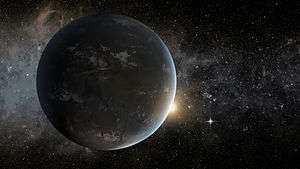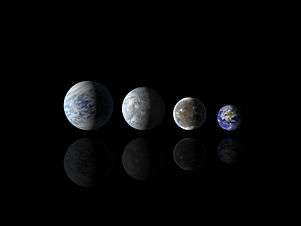2011 BT15
| Discovery[1] | |
|---|---|
| Discovered by | Pan-STARRS (F51) |
| Discovery date | 24 January 2011 |
| Designations | |
| MPC designation | 2011 BT15 |
|
Apollo NEO, PHA[2] | |
| Orbital characteristics[2] | |
| Epoch 13 January 2016 (JD 2457400.5) | |
| Uncertainty parameter 0 | |
| Observation arc | 2395 days (6.56 yr) |
| Aphelion | 1.6868 AU (252.34 Gm) (Q) |
| Perihelion | 0.90238 AU (134.994 Gm) (q) |
| 1.2946 AU (193.67 Gm) (a) | |
| Eccentricity | 0.30296 (e) |
| 1.47 yr (538.02 d) | |
| 162.47° (M) | |
| 0° 40m 8.832s /day (n) | |
| Inclination | 1.6650° (i) |
| 105.76° (Ω) | |
| 308.27° (ω) | |
| Earth MOID | 0.000927644 AU (138,773.6 km) |
| Jupiter MOID | 3.67132 AU (549.222 Gm) |
| Physical characteristics | |
| Dimensions | ~150 meters (490 ft)[3] |
| Mass | 4.9×109 kg (assumed)[3] |
| 0.109138 h (0.0045474 d) | |
| 21.8[2] | |
|
| |
2011 BT15 (also written 2011 BT15) is an Apollo near-Earth asteroid and potentially hazardous object.[2] In 2013 it had the 5th highest impact threat on the Palermo Technical Impact Hazard Scale.[4] It was discovered on 24 January 2011 by Pan-STARRS at an apparent magnitude of 22 using a 1.8-meter (71 in) Ritchey–Chrétien telescope.[1] It has an estimated diameter of 150 meters (490 ft).[3] It was removed from the Sentry Risk Table on 17 June 2013.[5]
Before the 2013 recovery it had an observation arc of 41 days with an uncertainty parameter of 7. Due to precovery images from 2007 it now has an observation arc of more than 5 years.[2] It makes close approaches to Earth and Mars.[6] While listed on the Sentry Risk Table, virtual clones of the asteroid that fit the uncertainty region in the known trajectory showed a 1 in 71,000 chance that the asteroid could impact Earth on 5 January 2080.[3] With a 2080 Palermo Technical Scale of −3.58,[3] the odds of impact by 2011 BT15 in 2080 were about 3800 times less[7] than the background hazard level of Earth impacts which is defined as the average risk posed by objects of the same size or larger over the years until the date of the potential impact.[8] JPL Horizons shows that the nominal pass will be on 17 January 2080 at a distance of 0.125 AU (18,700,000 km; 11,600,000 mi) from Earth.[9] 2011 BT15 passed 0.03222 AU (4,820,000 km; 2,995,000 mi) from Earth on 28 December 2013.[6] The December 2013 passage was studied by the Goldstone Deep Space Network and further refined the orbit.[10]
References
- 1 2 "MPEC 2011-B43 : 2011 BT15". IAU Minor Planet Center. 2011-01-27. Retrieved 2013-01-10. (K11B15T)
- 1 2 3 4 5 "JPL Small-Body Database Browser: (2011 BT15)" (last observation: 2013-07-18; arc: 5.9 years). Jet Propulsion Laboratory. Retrieved 31 March 2016.
- 1 2 3 4 5 "Earth Impact Risk Summary: 2011 BT15". Wayback Machine: NASA/JPL Near-Earth Object Program Office. Archived from the original on February 18, 2013. Retrieved 2013-07-27. (1.4e-05 = 1 in 71,000 chance)
- ↑ "Sentry Risk Table". Wayback Machine: NASA/JPL Near-Earth Object Program Office. 10 Jan 2013. Archived from the original on January 10, 2013. Retrieved 2013-07-27.
- ↑ "Date/Time Removed". NASA/JPL Near-Earth Object Program Office. Retrieved 2013-07-27.
- 1 2 "JPL Close-Approach Data: (2011 BT15)" (last observation: 2013-07-18; arc: 5.9 years). Retrieved 2013-01-10.
- ↑ Math: 103.58 = 3801
- ↑ "The Palermo Technical Impact Hazard Scale". NASA/JPL Near-Earth Object Program Office. 31 Aug 2005. Retrieved 2011-10-14.
- ↑ Horizons output. "Horizon Online Ephemeris System". Retrieved 2013-01-10. (Geocentric Solution)
- ↑ Dr. Lance A. M. Benner (2013-08-12). "Goldstone Asteroid Schedule". NASA/JPL Asteroid Radar Research. Retrieved 2013-08-16.
External links
- Orbital simulation from JPL (Java) / Ephemeris
- 2011 BT15 at the JPL Small-Body Database



